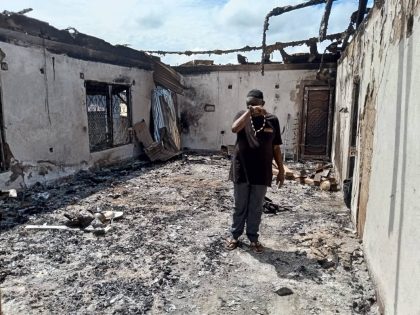Music pours down in Lima
The music of Peru's capital: from the cumbia chicha bands of the local huekos, the punk-rock revival, electrocumbia sounds, and much more.

Photo: Pool Olortiga Ramirez, via Flickr CC.
It never rains in Lima. Even if this is not entirely true, you are likely to hear Peruvians say this often about their capital on the shore of the Pacific Ocean. It is humid, but temperate out there, and though there is (almost) no rain, there are always clouds closing over the Limeño sky.
Maybe this is why, when I think about the music of Lima, I first think about introspective bands with beautifully arranged bittersweet, rueful songs. But this city of nine million people (about 30% of Peru’s total population) has plenty to offer, from the cumbia chicha bands of the local huekos, to a punk-rock revival, to a never-ending supply of electrocumbia sounds, and much more.
This is why we’re bringing you a new edition of Teca right from the City of Kings, with some of the hippest and coolest limeño bands. Here’s our brief selection:
Kanaku y el Tigre
Bruno Bellatín and Nicolás Saba had been playing music together for over 15 years in Lima. They collaborated often, but had their own projects. Then, Saba started to call himself “El Tigre.” One day, Bellatín realized they were collaborating all the time, so he thought maybe he should find a name for himself to accompany “El Tigre.” He chose “Kanaku,” which Bellatín says is “a call to introspection.” And, thus, Kanaku y el Tigre was born.
They play banjos, ukuleles, Peruvian charangos, as well as various toy instruments, and they got some people to play drums, percussions and horns, too. They say their sound is “Peruvian Psychedelic Funk,” but that seems to fall short to describe the beautiful simplicity of their songs, which may appear bare upon first inspection, but are truly rich and decorated.
They debuted with the album Caracoles in late 2010 (from which the below track, “Bicicleta,” comes from), with which they became known around the Latin American indie scene. Last year, they followed up with Quema, Quema, Quema, which features cover art designed by hyper-famous Argentinean cartoonist Liniers, as well as the sounds of more traditionally pop/rock instruments and beats, but still with a definitive style.
Tourista
Legend has it that, a few years ago, Rui Pereira decided to move to the Lima beach to record a demo. One day, Sandro Labenita dreamed he was in a band with Rui. Sandro told Rui of this dream and they decided to come together to form Tourista, a dance-rock, indie-pop trio (completed by the synth-master known as Genko) that has gotten airplay throughout Peru.
They debuted in 2012 with their EP Déficit de atención, fast-paced, danceable punk-rock music aided by synths, loops and Pereira’s catchy lyrics. This week they will debut a new album, Colores paganos, which they promise will be filled with more Afro-Peruvian instruments, as well as more Andean and tropical melodies.
The first single from Colores paganos, “Select y Start,” promises a much slower, more introspective record. But for now, here is the song that made me love them:
La Lá
In 2014, the singer/songwriter La Lá released her album Rosa which, I hope, was played next to many lit fireplaces, or within reach of ocean waves. Her music is, as her website describes it, the music of intimacy, music that “invites you to take a nap in the sofa, or drink a tea while you look out the window after having lunch.”
It is a very fragile, internal, personal state, and the minimal arrangements do perfect justice to La Lá’s voice, a voice that slowly wraps around you and keeps you comfort. So get the wine out, dim the lights, and listen to her powerfully subtle vocals:
Pamela Rodríguez
Wow, 2011 was five years ago? That’s when Pamela Rodríguez released her latest album, Reconocer, an indie record that still sounds relevant. There, she sings in a way that makes you listen to what she’s saying, with a particular twist to the female singing voice that has become common in some Latin American indie acts.
Her singing voice and style has changed considerably from her debut album Peru Blue (2005) and her second record La orilla (2008), but I believe it has changed for the better. Fortunately, for those of us who wanted to hear her again, last year Pamela released a song (or EP?) in four movements: Una herida hecha luz.
Amadeo Gonzales
Are you looking for a Peruvian folk idol who is also a cartoonist, a graphic artist and a bit of a legend in the fanzine movement? Well, look no further than Amadeo Gonzales, who is all of that and maybe a bit more.
Amadeo and his brother Renso have published the cartoon fanzine Carboncito since 2001 and they have worked in many other cartoon publications since then. Amadeo has also worked extensively in concert posters and various graphic design projects. His work has been showcased in galleries throughout Peru. And he has also recorded two albums Mostros, marcianos y rocanrol (2011) and Perro de la calle (2014).
Both of them are very simple affairs. Amadeo, the self-taught musician, is not looking to get complex or layered in his recordings, just to create catchy, witty tunes. And he definitely succeeds. In particular in his song “El marciano,” in which a Martian says something unintelligible to Amadeo, until its warning becomes clear:
Also check out: surf-rockers Almirante Ackbar, synth-pop experimenters Las Amigas de Nadie, indie pop melancholic Mondebel, Nico Saba’s side project Los X Conchas Negras, techno cumbia masters of ceremonies Dengue Dengue Dengue!, and whatever the guys at El Chico del Pórtico have to showcase.



















